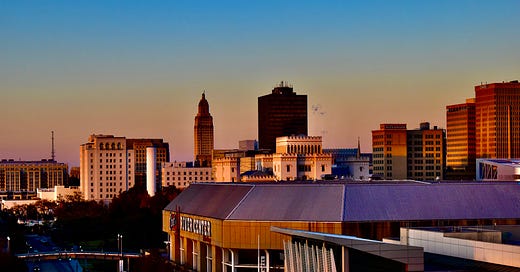Downtown Hotels Are BRinging It
Staying downtown can be expensive, but many travelers don't mind paying the extra cost. What does this mean for the city-parish?
Travel came back with a vengeance in 2022, and a year’s worth of data demonstrates the importance of downtown hotels when it comes to local tourism1. Downtown revitalization was a big theme of BRAC’s recent Canvas trip to Greenville, SC, and ensuing conversations have focused on strategies for building a vibrant downtown for businesses, residents, and tourists. Last year, downtown hotels outperformed the average for all East Baton Rouge hotels in two key metrics: occupancy rates and revenues per available room. While all hotels in East Baton Rouge serve important roles for surrounding residents, businesses, and cultural amenities, this Substack will focus on the role downtown, including its hotels, might play in the broader community.
From February through November, downtown hotels consistently averaged higher occupancy rates than the city-parish at-large. In March of last year, downtown hotels averaged 81% occupancy compared to 71% for all East Baton Rouge hotels. It’s important to point out that 71% represents average occupancy for all hotels in March, including downtown hotels. This means that hotels outside of downtown collectively had average occupancy rates below 71% that month. Downtown hotels appear to be buoying the parishwide average.
Aside from January, downtown hotels had occupancy rates that were, on average, nearly 12 percentage points higher than the average for all hotels. The largest difference came in June when downtown hotels boasted a 77% average occupancy rate compared to 61% for all East Baton Rouge hotels.
Not only are downtown hotels filling a greater share of their hotel rooms, but they’re also generating more revenue. Understood to be the “gold standard” for measuring hotel performance2, revenue per available room (revPAR) measures the revenue generated per all rooms in a hotel regardless of whether rooms are occupied. From September through November last year, downtown hotels’ monthly average revPAR was anywhere from $42 to $56 higher than the parishwide average. Again, like with occupancy, the revPAR of all hotels includes downtown hotels which means that hotels downtown are propping up the Baton Rouge average.
RevPAR shouldn’t be looked at in isolation. It doesn’t take into account expenses, meaning a higher revPAR is not the same as a greater profit margin. Hotels charging lower rates/room may have lower revPARs than more expensive hotels even when occupancy is higher. Most of Baton Rouge’s priciest hotels can be found downtown which, when coupled with higher occupancy rates, naturally leads to higher revPARs for the area.
While revPAR may be useful for measuring hotel performance, it doesn’t totally capture consumer preferences. Only a handful of hotels are found downtown, most of them charging above-average rates. Hotels charging lower rates can be found across the parish, demonstrating the wide appeal that more affordable hotels have for tourists and business travelers alike. The occupancy rate data shows that plenty of people willingly pay a premium to stay downtown though, pointing to the value that many place on staying within walking distance to all that downtown has to offer.
Stating the obvious?
It may come as no surprise that downtown hotels are outperforming the parish average. Many social and cultural amenities are concentrated in or near downtown, as are an increasing number of residents. Historically speaking, “downtown” was synonymous with “central business district.” Today, downtown areas in cities across the country are the heartbeat of both business and community generally. Downtown Baton Rouge is home to everything from the Live After Five seasonal concert series to the River Center’s extensive calendar of events to Baton Rouge Mardi Gras where five of the city’s eight parades roll through downtown streets.
This hotel data shows that Downtown Baton Rouge, in addition to hosting a lot of community-centered events for residents, is also the face of the community to many travelers and tourists. When conference attendees, football fans, or cultural aficionados visit the Capital Region, there’s a good chance they’re staying downtown. Even those who aren’t staying in a hotel overnight are more likely to experience Baton Rouge through our downtown. Hundreds of Mississippi River cruise ships disembark in Downtown Baton Rouge each year, and cruisegoers on walking tours are a frequent sight on downtown streets. Just last weekend the Louisiana Marathon, which hosted almost five thousand runners from 47 states and numerous countries, started and finished downtown.
In addition to the Canvas-inspired conversations around downtown revitalization, there’s an ongoing effort to better retain our almost 60,000 college students while attracting new talent from outside the region. An attractive downtown, with its high density of restaurants, bars, and other fun things to do will play a strong role in convincing young 20-somethings to stay here after graduation. And when out-of-region talent flies into the Capital Region for a weekend to decide if this is a place they want to call home - well, we can make a good guess where they’ll be staying.
All data in this report comes from STR, courtesy of Visit Baton Rouge
https://str.com/data-insights-blog/what-is-revpar





